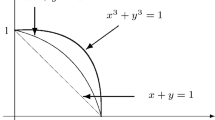Abstract
In this paper we firstly review the definition of fuzzy semi-numbers and study some of their properties. Then, we consider some methods for converting fuzzy semi-numbers to fuzzy numbers in order to find the distance between fuzzy semi-numbers. By presenting a new distance function, we also find the distance between fuzzy semi-numbers directly without any change to their originality. Finally, we prove some properties of the presented distance and study a practical motivational medical case study along with some numerical examples.







Similar content being viewed by others
References
Abbasbandy S, Amirfakhrian M (2006a) The nearest approximation of a fuzzy quantity in parametric form. J Appl Math Comput 172:624–632
Abbasbandy S, Amirfakhrian M (2006b) The nearest trapezoidal form of a generalized left right fuzzy number. J Approx Reason 43:166–178
Allahviranloo T, Abbasbandy S, Sanaeifard R (2011) A method for ranking fuzzy numbers using new weighted distance. Math Comput Appl 16(2):359–369
Amirfakhrian M (2010) Properties of parametric form approximation operator of fuzzy numbers. Analele Stiintifice ale Universitatii Ovidius Constanta 18:23–34
Anzilli L, Facchinetti G, Mastroleo G (2014) A parametric approach to evaluate fuzzy quantities. Fuzzy Sets Syst 250:110–133
Chang CL (1968) Fuzzy topological spaces. J Math Anal Appl 24(1):182–190
Cullen DJ et al (1972) Clinical signs of anesthesia. Anesthesiology 36:21–36
Delgado M, Vila MA, Voxman W (1998) On a canonical representation of fuzzy numbers. Fuzzy Sets Syst 93:125–135
Dubois D, Prade H (1978) Operations on fuzzy numbers. Int J Syst Sci 9:613–626
Dubois D, Prade H (1980) Fuzzy sets and systems: theory and application. Academic Press, New York
Grzegorzewski P (1998) Metrics and Orders in Space of Fuzzy Numbers. Fuzzy Sets Syst 97:83–94
Grzegorzewski P (2002) Nearest interval approximation of a fuzzy number. Fuzzy Sets Syst 130:321–330
Grzegorzewski P, Mrówka E (2003) Trapezoidal approximations of fuzzy numbers. In: Bilgic T, DeBaets B, Kaynak O (eds) Fuzzy sets and systems, IFSA 2003. Lecture notes in artificial intelligence, vol 2715. Springer, pp 237–244
Grzegorzewski P, Mrówka E (2005) Trapezoidal approximations of fuzzy numbers. Fuzzy Sets Syst 153:115–135
Kaleva O (1985) The completion of fuzzy metric spaces. J Math Anal Appl 109:194–198
Kaleva O (2008) A comment on the completion of fuzzy metric spaces. Fuzzy Sets Syst 159(16):2190–2192
Kaleva O, Seikkala S (1984) On fuzzy metric spaces. Fuzzy Sets Syst 12:215–229
Li G, Warner M, Lang BH, Huang L, Sun LS (2009) Epidemiology of anesthesia-related mortality in the United States, 1999–2005. Anesthesiology 110(4):759–765
Lowen R (1976) Fuzzy topological spaces and fuzzy compactness. J Math Anal Appl 56:621–633
Ma M, Friedman M, Kandel A (1999) A new fuzzy arithmetic. Fuzzy Sets Syst 108:83–90
Ma M, Kandel A, Friedman M (2000) A new approach for defuzzification. Fuzzy Sets Syst 111:351–356
Ma M, Kandel A, Friedman M (2002) Correction to “A new approach for defuzzification”. Fuzzy Sets Syst 128:133–134
Voxman W (1998) Some remarks on distance between fuzzy numbers. Fuzzy Sets Syst 100:353–365
Ying H, Sheppard LC (1994) Regulating mean arterial pressure in postsurgical cardiac patients. IEEE Eng Med Biol Mag 13(5):671–677
Zbinden AM, Feigenwinter P, Petersen-felix S, Hacisalizade S (1995) Arterial pressure control with isoflurane using fuzzy logic. Br J Anaesth 74:66–72
Zimmermann HJ (1991) Fuzzy set theory and its applications, 2nd edn. Kluwer Academic, Boston
Author information
Authors and Affiliations
Corresponding author
Ethics declarations
Conflict of interest
All Authors declare that they have no conflict of interest.
Additional information
Communicated by A. Di Nola.
Rights and permissions
About this article
Cite this article
Amirfakhrian, M., Yeganehmanesh, S. & Grzegorzewski, P. A new distance on fuzzy semi-numbers. Soft Comput 22, 4511–4524 (2018). https://doi.org/10.1007/s00500-017-2902-2
Published:
Issue Date:
DOI: https://doi.org/10.1007/s00500-017-2902-2




